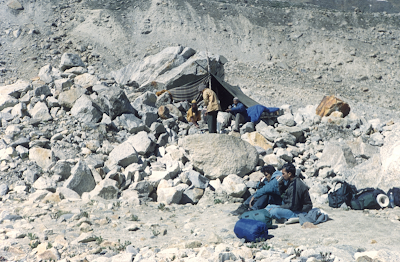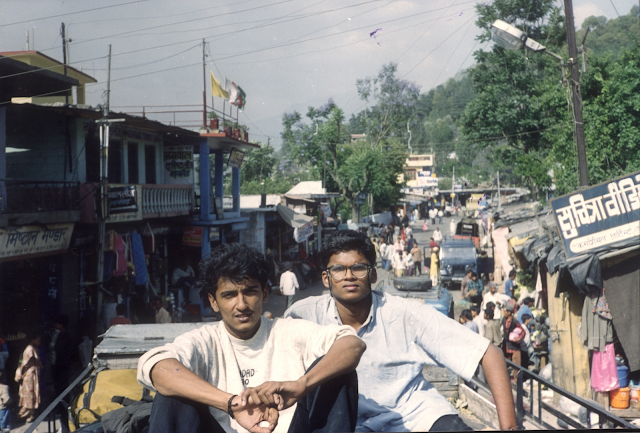Part 1 can be
found here.
We woke up early in the morning. The candle light dinner and the basic accommodation did nothing to dampen our spirits. Possibly, this was the way we visualized it. Sleeping on the cement floor in a sleeping bag. Here's a view from Gangotri.
We started walking up from the temple, by around 8 in the morning.
The initial few hundred metres are punishing on those who come from the valleys. Till you reach the check post - after that it's not so hard, at least for some time. At the check post, they charge you some basic fees plus a deposit based on the number of plastic articles you're carrying. While coming back from the trek, if you have a lesser number of plastic items, the deposit is forfeited. This practice is still there as I gleefully discovered in one my later visits. The economic incentive aside, it creates an awareness not to throw plastic items around.
The first pit stop is Chirbasa, a couple of kilometers from Gangotri. It has a few small temporary outlets where you can have basic food. They let weary travelers plonk inside their shops while they prepare tea and whatever you chose to order (noodles mostly). You would be lying down tired, but what rejuvenates you is the smell of the hot brew mixed with herbs that waft into your senses along with the mountain wind and the roar of the adolescent Bhagirathi river in the background. Chirbasa set up a surprise for me a few years later, when I took my entire family to Gomukh. That time around, we traveled on ponies, because I thought the trek might be tough for my parents and in-laws. While moving out of Chirbasa, the lousy teenager who was walking my pony hit it really hard while it was facing a two feet high rock. The pony jumped up the rock and fell forward. And yes, I was sitting on top. I remember falling over it's head (my wife screaming in the background), rolling a few meters down the incline before I somehow arrested my fall. Thankfully, I escaped with a few bruises and a broken camera.

After Chirbasa, the scenario changes. The next stop is at Bhojbasa (named after Bhojpatra/birch trees), about 6 kilometres ahead. There are sections in this stretch that are dangerous, with paths about two feet wide, with the threat of rolling stones from above. Our guide, Raawatji, proved to be very useful throughout. He had just one major weakness - his 2-in-1 tape recorder. It wouldn't have been a weakness, had he not had another minor weakness at that point in time -
dil to paagal hai. He loved the song so much and just kept rewinding and playing that track throughout our trek, that I got totally psyched out. Not even the nascent Bhagirathi could silence the "
pehli pehli baar, milata hey yehi". I hated it then, but when I write this, all I have to do is listen to the song on youtube and the trek feels like it only happened like yesterday (ok, ok, day before yesterday).
We were going at a very rapid pace for people from the plains, and after some point I requested Raawatji to stop. I think it was at Bhojbasa, where there are places to stay. Raawatji refused and said that he could arrange for accomodation at Gomukh itself. The refusal is the reason why I look miffed in the photo below.
After a lot of huffing and puffing and cursing for about 5 kilometers, we did finally reach the marker that announced our arrival at Gomukh.
Now what? The marker can wait, because we had to walk up further to see Gomukh, the last line of the glacier which looks like (hypothetically speaking) the snout of a cow from which the River Ganga/Bhagirathi emerges. It is a magnificent sight, but with the temperature dropping, we did little to appreciate the beauty of the glacier and the mountain backdrop at that point.
Raawatji had gone to arrange accommodation. There was a baba who stayed in a tent near Gomukh who had a spare tent gifted by foreigners. Thankfully, the tent was free, and there we stayed that night - bang in front of the Gomukh glacier - I don't know how many stars lit up the sky that night (not that I walked out to check), but that was truly a multi-starrer accommodation for the sheer location.
That evening, a Bengali team who were on their way back to Bhojbasa walked into our tent just to say hi. The leader of the pack brought out his cigarette factory, and in 15 minutes, I learned the art of rolling cigarettes - adding tobacco to the paper, rolling it, licking it to seal, and lighting up. Talk about heights of learning.
Baba's attendant made dinner for us that night. I ate just a little (my appetite dead), and so did Sumesh, but Somnath was hungry and kind of binged. He did have a puking episode later in the night (or was it the next day morning?). The night was an experience in itself. The mountain winds howled throughout and buffeted our tent, and despite the best temperature protection that I could afford, I found myself in a troubled shivery state.

I woke up complaining at about 6 in the morning and walked out of the tent. What I saw stunned me. No, it was not the magnificent glacier that appealed to me. I saw an elderly couple walking back from Gomukh, in wet clothes (may be they took a dip in the water) that could at best be described as a villager's daily wear. And I was thinking, these folks must have started from Bhojbasa an hour or two back, taken a dip, and are now walking back. And here I was, in my woolens and jackets and twin gloves, complaining about temperature. What drove them, as far I could comprehend, was pure faith, however blind it may be.
That's us, having breakfast.
Raawatji is the fellow sitting next to the baba. We asked Raawatji about the baba's pedigree and he told us "
Baba pehle goli chalathe the." (a.k.a Baba used to fiddle around with guns before - for the lack of a better translation.) We did not prod further, and for all these years, I have had this nagging doubt, whether the baba was a bandit or a military personnel, before he took this identity.
Next stop - Tapovan, the grassy meadow overlooking the glacier, about 6 kilometers away. We got on top of the Gomukh glacier and started walking up. Raawatji was most helpful during this part of the trek. We were mostly going vertical, on what was a dirty treacherous mix of slippery ice, rock, gravel, and dirt. We reached Tapovan in about 3 hours. That's Sumesh in Tapovan (about 4450 m -16,600 feet).
I still do not know why we did not pay a visit to the Mata who stays in a little cottage in Tapovan, most of of the year. The day is still a blur to me. Tapovan wasn't as green as we had anticipated, because the snow had just melted, but it was beautiful with the Himalayan peaks in the background, some climbing tents in the distance, and the pretty little stream that ran through it. I will make amends for my blurriness by revisiting it, some time soon.
And, to be honest, I don't remember how we came down. There's a pic of me walking down.
We walked all the way back to Gangotri that night. For the benefit of future trekkers, the trek to Gomukh is not so arduous as the altitude gain is limited from 3,200 m at Gangotri to about 3,900 m at Gomukh over 18 or 19 kilometers. The distance helps by flattening out the elevation gain, but the flipside is that it tires your limbs. I would recommend staying in Bhojbasa, and doing the Gomukh-Tapovan-Bhojbasa route in a day.
I think we reached Uttarkashi the next day. My non-vegetarian turrets had started acting up after days of vegetarian
food. Thankfully, the Uttarkashi restaurant that we went to served rotis and a
curry which had a lot of oil with pieces of so-called mutton floating in it. It
tasted awful, but it comforted me. While we were sitting there, we heard a
foreigner asking the waiter, "
What's this?" in a stentorian voice. The waiter replied, "
Sir, this is bhindi" as though bhindi is the most natural word for a firang. And the foreigner barked back - "
What's BHINDII?" We laughed at the situation then, but I have to give it to the waiter. He looked flustered for a few seconds, but then came back - "
Sir..this is ladies finger." And the guy just shut up with a "
aah, ok".
We went to Kedar and Badri afterwords, and went back home, but not before experiencing the taste of Sher-e-Punjab cuisine in Jwalapur, and the roughness of Mulayam Singh Yadav's
kisan (farmer) rally that robbed us of our first class train seats from Haridwar to Delhi (and forced us to sleep in the compartment corridors). Rough ride!
In college, I had a shortage of attendance that semester. I gave the trip explanation to my Dean (while maintaining a studied silence about all the other leaves that I took). He brushed off my excuse saying that such trips should only be taken at a later stage in life. I have been following his advice ever since. ;)


















